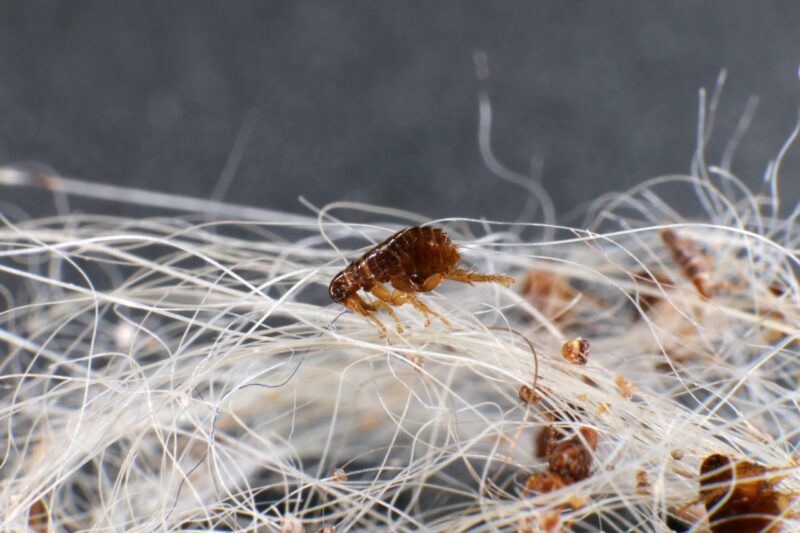Does UV Light Kill Fleas? Vet-Reviewed Facts & Effectiveness

Updated on

Click to Skip Ahead
Ultraviolet (UV) light has many purposes, including sterilizing biological safety hoods and inducing mutations in lab experiments, but can it kill fleas? Yes, but it may not be the most practical option.
Because UV light mutates the genetic code, it’s effective at killing many organisms directly or indirectly with radiation. But as far as home use to control fleas on pets, it’s more of a hazard than other flea treatments.
Understanding UV Radiation
UV radiation is like visible light in many ways, but it doesn’t help us see. Though it’s similar to other types of electromagnetic radiation like visible light and radio signals, different wavelengths have different effects.
There are three types of UV radiation:
- UVA, a long-wave UV ray that comprises most of the light that reaches the Earth from the sun. Though not as harmful as other rays, UVA is still harmful, especially over the long term.
- UVB, a medium-wave UV ray that is mostly filtered out by the ozone layer. Some reach the Earth and are responsible for most of the harmful effects of UV exposure, including sunburn, premature aging, and skin cancer.
- UVC, a short-wave UV ray that’s filtered out by the ozone layer but exists in artificial sources to kill bacteria and is the most damaging form of UV radiation.
Sunlight is a natural source of UV radiation, but there are plenty of artificial UV light sources that are used in industrial processes. For example, in medical and dental practices, UV light is used to kill bacteria, cure inks and resins, create fluorescent effects, and administer phototherapy.
Unfortunately, with all these examples, there’s a risk with UV exposure that must be balanced. Some UV exposure is fine—healthy, even—but excessive exposure can cause skin cancer, sunburn, accelerated aging, eye diseases, and a suppressed immune system. This goes for not only humans but animals as well.

How Does UV Light Kill?
UV light kills cells by damaging the DNA. It initiates a reaction between two molecules of thymine, which are part of DNA, resulting in a thymine dimer to repair the cell.
The longer and more intense the exposure, the more thymine dimers are formed in the DNA. This increases the risk of an error or missed dimer, potentially affecting the cell’s ability to complete its necessary functions. The cell will either die completely or cancerous cells form from the healthy cells.
In short, UV kills cells because of the accumulation of DNA damage. This is how UV radiation can be used to kill insects and other pests.
UV Light for Fleas
Like other organisms, fleas aren’t immune to the effects of UV light, especially UVC. When adult fleas are exposed to 280 nanometers UVC light for 30 minutes at a distance of 10 centimeters, they die. Flea eggs, on the other hand, can be killed by exposure to 100 to 280 nanometers of UVC light for 15 to 30 minutes at 20 centimeters.
However, this is in a controlled setting. Fleas must be consistently close enough to the UVC light source for the appropriate length of time. Adult fleas may move away from the light if it gets hot and uncomfortable as well, hiding out until it’s safe.
Depending on the extent of the infestation, it could take a long time with a UV lamp to eradicate fleas and ensure that the entire lifecycle is disrupted. And if you have an active infestation on your dog or cat, you will need to treat them separately.
It’s not safe to use UV light directly on your pet, as UV exposure is as dangerous for pets as it is for us. The potential damage caused by UVC exposure far exceeds any concerns over flea baths or topical flea treatments.

Use Flea & Tick Prevention
Both fleas and ticks are parasitic creatures that feed on the blood of people and animals. They’re found all over the world and can appear at any time of year, though you’re more likely to see infestations in spring, summer, and early fall in certain climates.
At the least, fleas and ticks can cause itching and irritation through their bites. In severe cases, they can cause a severe allergic reaction or flea- and tick-borne diseases. Fleas can transmit serious diseases like flea-borne spotted fever, murine typhus, bartonellosis, or cat scratch fever. Ticks also carry serious diseases like Lyme disease, ehrlichiosis, babesiosis, anaplasmosis, rickettsiosis, and tularemia.
Both fleas and ticks can start out on your pet and may end up on you, causing any number of diseases. Even if ticks and fleas don’t seem to be a problem for your area or pets, it’s best to use veterinary-approved flea and tick prevention year-round instead of home remedies or seasonal treatments.
Fortunately, pet owners are spoiled for choice with modern flea and tick prevention. You have options for topical treatments, oral treatments, baths, dips, and collars. Speak with your vet about your options and determine which treatment is the best for your pet’s health history, lifestyle, and your needs and preferences.
Conclusion
UV light can kill virtually any organism with enough exposure, including fleas. Though this can be effective, it’s hardly a practical option to use in your home, and you should NEVER use UV light on yourself or your pets to eradicate fleas. If you’re dealing with a flea infestation, talk to your vet about safer options to treat your pet and kill all the fleas in your home.
Read Also:
- Does Bleach Kill Fleas? Safety & Effectiveness Explained
- Does Boric Acid Kill Fleas? Safety & Effectiveness Explained
Featured Image Credit: Nor Gal, Shutterstock











